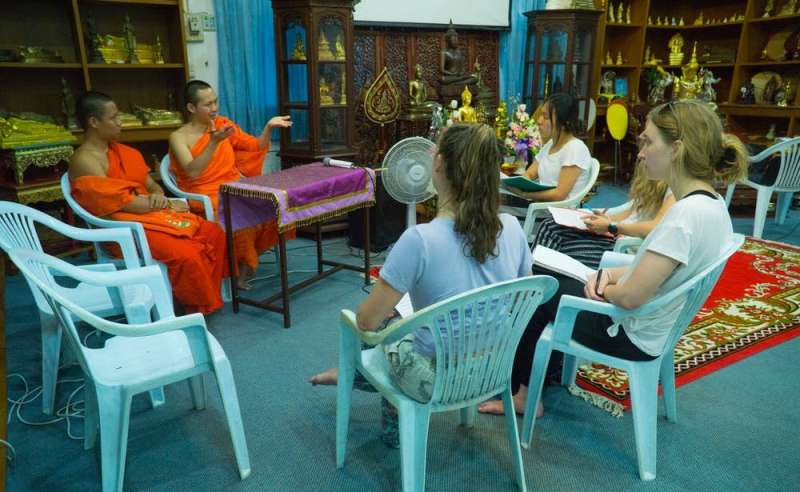The pandemic has slowed tourism to Thailand's Buddhist temples, but the impact is more than economic

The economies of countries dependent on tourism are clearly hurting, with visitor numbers plummeting as a result of the pandemic.
In Thailand alone, a country where tourism accounts for , the . During December 2020—typically a peak tourism month—the country received just over 6,000 foreign tourists—a , when there were nearly 4 million foreign tourists.
The Thai government estimates a Thai baht (over US$3 billion) in the first quarter of 2020 and a loss of about as a result of this slump in tourism.
However, the actual loss cannot be captured in these numbers alone. Many cross-cultural exchange opportunities have been lost as well.
I spent much of the previous decade living in Chiang Mai, a medium-sized city in northern Thailand, . As a scholar who was studying the in the region before the pandemic started, I am able to assess the impact of COVID-19 on these sites of religious importance.
Some Buddhist temples that relied heavily on donations from foreign tourists are now . Additionally, small businesses around temples have been badly hurt, as is the knowledge exchange with international visitors.
Temples and tourism
Before the pandemic, Wat Phra Chetuphon, known more commonly as Wat Pho and one of the most-visited temples in Bangkok, would receive about . Foreign tourists pay an entry fee of 200 baht, or $6.40, while Thai people enter free of charge.
In an in January 2021 with Thai news outlet Prachachat, the assistant abbot of Wat Pho stated that the temple can weather this period without tourists for now, but not for much longer. With donations from Thai people, they were able to pay basic expenses of water and electricity and employ cleaning and security staff. But without the foreign tourist fees, it would become difficult to meet the .
Foreign visitor numbers are also scarce in the most famous temple in Bangkok, Wat Phra Kaew, or the Temple of the Emerald Buddha. This temple is part of the Grand Palace, the Thai royal family's former residence. In 2016, the Grand Palace was named one of the world's in the world by Travel + Leisure magazine, with over 8 million visitors per year.
Typically, the high tourist season would see a long line for entry and crowds of people inside, with foreigners paying $16 for entrance to the temple and the Grand Palace. Again, there is no entrance fee for Thai citizens.
Losses have been significant, for members of the monastic community and small businesses that thrive near these famous temple complexes. Many vendors who sell water, street food and souvenirs around the temple have . Many of these people work within Thailand's informal economy. A 2018 survey found found employment through this informal economy.
Cultural exchange
Much of the the loss of the engagement between foreign tourists and the monastic community cannot be measured in monetary terms. highlights the energy and effort student monks put into creating programs for foreign tourists to learn about their religion, many aimed at travelers or student groups on college or gap-year programs.
, I have found these cultural exchange programs to be beneficial for tourists and the goals of Buddhist monasticism. Several in developing or underdeveloped nations to provide support to those in need. At the same time, these volunteer tourists immerse themselves in different cultures, religions and ways of life.
In Thailand, volunteer tourists typically teach English and could also live in a temple for several months. In my interviews, these tourists said that the experience enabled them to learn about themselves, reflect on their own values and consider .
Buddhist monks see it as to all who are curious. One program, called , which is hosted by the Buddhist temple Wat Suan Dok and the MahaChulalongkorn Buddhist University, facilitates between monks and foreign travelers in English.
Monks who participate in these programs say that they often develop new ways of thinking based on their discussions with foreigners—from becoming more accepting of cultural differences to being pushed to think deeply about the monastic lifestyle.
For example, when I asked, "How have you changed as a result of meeting foreign tourists?" that he used to just accept the monastic rules and practices without considering their purpose. However, after tourists asked why he shaved his head and wore yellow robes, he considered the ways that his lack of hair and uniform were part of a simple lifestyle. He understood more deeply that monks must give up such expressions of individuality as hairstyle and fashion preferences.
Because of the pandemic, Monk Chat has switched to an online outreach. Since April 2020, is streamed almost every week via Facebook, where various guests, usually monks, prepare some reflections on a specific topic related to Buddhism in the modern world, such as life lessons from COVID-19.
Facebook Live is a good alternative for now, but it does not have the same impact as talking directly with foreigners. The format is more formal, with little chance for personal sharing or observing the playful ways monks interact with one another.
It is difficult to measure these losses, but undoubtedly they will leave a deep impact for some time to come.
Provided by The Conversation
This article is republished from under a Creative Commons license. Read the .![]()
















